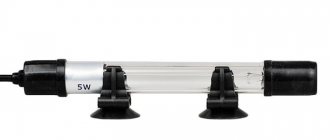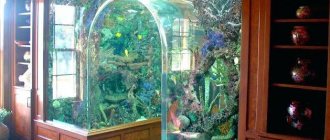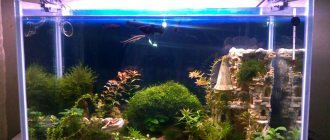As is known, water in a confined space tends to provoke the proliferation of microorganisms contained in it. As a result, its properties deteriorate, an unpleasant odor appears, and further use becomes impossible. Therefore, a UV aquarium sterilizer is practically necessary in this case.
A UV sterilizer for an aquarium is needed to prevent the development of unnecessary microorganisms
Principle of operation
Sterilizers with UV radiation are well known to experienced aquarists, but beginners are often lost, not knowing what the device is for and for what purpose. First, you should study the structure of the device:
- The device consists of a tube equipped with 2 fittings - for inlet and outlet of water.
- Inside the devices there are ultraviolet lamps, the radiation of which purifies the liquid. After filtration and disinfection, the water is returned to the tank, mixing with the untreated liquid.
It is important to note that the radiation range of the device is small, so harmful elements and bacteria living in the substrate and on algae are not treated.
The ability of ultraviolet radiation in an aquarium to penetrate deep into the water column depends on the following factors:
- Liquid density - the higher the density, the less UV rays penetrate deep into the water column. In turbid and contaminated liquids, sterilizers will disinfect only a 5 mm layer. It is for this reason that the ultraviolet lamp in the device is placed after the filters so that the already filtered water is processed.
- Salinity – according to research, the device purifies fresh water better than salt water. This factor is due to the fact that the density of the salty liquid is higher.
- Careful handling - in order for the UV lamp to work effectively, the device is cleaned after each use. If there is a layer of dirt on the lamp, it will be useless.
Reasons for using ultraviolet light
The flora and fauna of aquariums are not an inert mass that never interacts with the environment. This is a constantly changing system that exchanges substances between all its participants. Among them there may be completely harmless organisms such as bacteria or various viruses, which often become the causes of serious diseases in fish.
And if for the average home aquarist the loss of several small pets is not a major tragedy, large specialized farms that grow certain species may lose the fruits of many years of work due to a sudden epidemic.
Therefore, to preserve the entire brood, ultraviolet sterilizers are used for the aquarium. The radiation they emit is lethal to most harmful organisms that may enter the tank.
An ultraviolet lamp will help prevent diseases in fish
Ultraviolet is the shortest waves of electromagnetic radiation that are outside the visible spectrum for human vision. There are several varieties that differ in the length of the emitted wave and, accordingly, in their penetrating and physical properties:
- A is the longest region and includes the range from 320 to 400 nanometers. Longer - only visible violet light. It is this species that reaches the Earth's surface after being filtered out by the atmosphere.
- B - average in the overall range (290-320 nm), more aggressive. Some of these rays also penetrate through the dense ozone layer of the atmosphere and are well tolerated by living organisms.
- C - the shortest spectrum waves possible in principle, the range is from 180 to 290 nanometers. They have no chance of reaching the surface and are fatal to most living beings.
Any rays can be used as disinfectants, since bacteria and viruses, due to their structure, do not have a natural barrier that would protect them.
Kinds
Aquarium sterilizers are divided into two broad groups according to method of use:
- Surface – devices consisting of light bulbs and a reflector. The structure is fixed at a height of 5-10 cm, and the liquid passing through the tray is sterilized by lamps. This type is not currently used.
- Submersible - include three subtypes: built into the filter, internal and external. The first and second subtypes have low efficiency due to the small size of the lamps, which automatically leads to low power. External type devices consist of a housing that houses an ultraviolet lamp in a quartz flask. This type is used by experienced aquarists to disinfect the aquatic environment, so beginners are also advised to choose an external UV sterilizer.
Device structure
There are several types of aquarium sterilizers. Internal devices are small in size. Their main power is also small, and therefore their effectiveness is considered low. Some manufacturers add the ability to install an additional UV lamp. External sterilizers are attached to the outlet of the external filter or to the pump. They are considered the most effective. The lamp is placed in a flask, so it is completely isolated from water. The flask is made only from quartz glass, since it transmits UV radiation well, while ordinary glass quickly absorbs it. As the water washes the flask, the process of destroying all microorganisms occurs.
The sterilizer is equipped with two fittings of different diameters so that they can be connected to different hoses of external filters. The sterilizer is installed in the rupture of the hose at the outlet of the external filter. To create a good flow of water, pumps are used. The slower the water flow, the more microorganisms it will kill. If the pump is low-power, then you shouldn’t buy an overly expensive lamp. It is better to install an external filter rather than a pump. In this case, the water is first mechanically purified, and only after that it enters the device.
In what cases are sterilizers used?
Ultraviolet lamps for aquariums are used in the following cases:
- Penetration of an infection into the reservoir that affects most pets.
- Quarantine for new fish.
- Blooming liquid in an artificial reservoir, a sharp and rotten smell from the water.
- Systematic use for preventive purposes.
- Overpopulation of reservoirs with residents and underwater flora.
Benefits of a UV lamp for an aquarium
The benefits of a UV sterilizer are great. Ultraviolet light can kill pathogenic bacteria, which allows fish in the aquarium to live longer and reduces the risk of disease. It purifies water and prevents the formation of turbidity. The liquid maintains optimal conditions for the life of aquarium fish longer. The lamp is considered an additional step in water purification. That's why they are sold together with aquarium filters.
Advantages and disadvantages of application
Like any device, for example, an aquarium sump, aquarium sterilizers have individual advantages and disadvantages, based on which each fish holder decides whether to use the device. The undoubted advantage of purchasing a device is that the bactericidal lamp really has a positive effect on the aquatic environment: it destroys harmful substances, neutralizes rotten odors and eliminates floating algae. However, the device also has disadvantages:
- When using the device, ultraviolet rays do not destroy all harmful bacteria - some acquire immunity and remain inside the reservoir. To eliminate this possibility, you should choose sterilizers with high power.
- The radiation from the device is not enough to reach the bottom of the container and destroy bacteria in the soil.
- The cost of sterilizers is high, so experienced aquarists build a UV sterilizer for an aquarium with their own hands. It is important to note that the ultraviolet lamp itself has a short service life and must be replaced after 6 months of operation.
Functions of a UV sterilizer
The light emanating from a UV lamp can quickly destroy pathogenic and disease-causing bacteria and algae. It is used if any disease is detected in the fish. This is especially true for ichthyophthyriosis. The lamp can also be used for preventive purposes. Modern UV sterilizers are used if an algae or bacterial outbreak is detected.
Aquarists notice a white cloud after starting the aquarium. It appears when pathogenic bacteria multiply rapidly. Since turbidity appears due to the activity of microorganisms, after a few days it disappears on its own. But using ultraviolet light can speed up this process. If you have an algae outbreak, you cannot do without a UV sterilizer.
The sterilizer helps in the fight against green euglena. With the help of special flagella, it moves and clings to protrusions and snags. Reproduction occurs quickly, so the effect of water bloom appears. In large bodies of water, it is preferable to combat algae using chemicals. In an aquarium, everything happens differently.
You can fight green euglena by darkening the aquarium for several days. The light is turned off and the container is covered with a thick cloth. But you need to provide proper aeration for the fish. It is better not to feed the fish during this period. Due to lack of light, the algae stops reproducing, and the water becomes clear again. If it is not possible to leave the aquarium without light, you need to use additional devices.
Operating rules
In order for the ultraviolet sterilizer to perform its job efficiently and last the required amount of time, you must follow the operating rules of the device:
- When using the sterilizer systematically, the owner must monitor the condition of the device: check the hoses, fittings and connections for leaks.
- If the device is used constantly, a deposit will form on the quartz flask, which should be carefully and carefully removed. If this is not done, the efficiency of the device will decrease.
- Ultraviolet bulbs have a short service life - 6 months from the first use. After six months, the lamp should be replaced with a new lamp.
- When working with the device turned on, you should not look at the light bulb - this is harmful to the eyes. In addition, during operation of the device, the owner can feel a slight aroma of ozone, which is natural and should not bother the aquarist.
Aquarium sterilizers, when handled with care and used correctly, can benefit the inhabitants of the underwater world. However, it is important not to forget about the recommendations for using the device, and not to turn on the device for fun, so as not to damage the biobalance of the aquarium.
Luminescent types T5 and T8
At the moment, fluorescent lamps are the best option for illuminating an aquarium. This type of artificial lighting is usually placed at the top, closer to the front wall. White light lamps (BL) or warm white light lamps (WL) are used. The lamps have an affordable price and a fairly high light output , which makes them even more attractive for choice. But you need to take into account that the spectral range of these lamps is small. In addition, the light of fluorescent lamps does not pass through the water column well, so it is recommended to use it together with reflectors in order to better diffuse the light at the bottom. Most often, T8 and T5 lamps are used in aquariums.
Properties and qualities of fluorescent lamps
Fluorescent lamps (L-lamps) are the first gas distribution lamps. The principle of operation is based on the effect of electric field discharges on gas, which is pumped into a sealed glass vessel. Such exposure produces strong radiation in the ultraviolet spectrum. The device produces intense and even light, ideal for illuminating aquariums of any size . L-lamps have high light output and low heat output. However, their light output directly depends on the color characteristics of the light, the length of the lamp and the ambient temperature. The optimal temperature for the operation of such devices is 5-25 ° C. Towards the end of operation, the lamp gives off less light, the ends of its tubes darken. Rated life of 10,000 hours. Power of L-lamps from 8 to 56 Watts. The average length is 20-120 cm. The color of the spectrum is indicated by numbers or letters. For example, /43 or /CW.
Disinfection efficiency
The effectiveness of disinfection largely depends on the design of the UV sterilizer . The effectiveness of a UV sterilizer in destroying microorganisms is measured in μW•s/cm2 and is called the lethal dose. For different types of organisms, lethal doses can vary greatly.
The effectiveness of using a UV sterilizer depends on the power of the lamp, the size of the working gap and the speed of water flow through the device.
- Low-power ultraviolet radiation does not destroy all types of pathogenic microorganisms. Some of them die when exposed to more powerful radiation. Therefore, the higher the power of the UV sterilizer , the more effective the water disinfection is. When choosing equipment, you should give preference to a more powerful device.
- The thickness of the treated water layer depends on the size of the working gap. Since water absorbs ultraviolet radiation very quickly, only the flow layer closest to the lamp will receive a sufficient dose of radiation. Accordingly, with an increased working gap between the two flasks of the device, for better treatment of water, it will be necessary to pass it through a UV sterilizer many times within one day. Reducing the working gap significantly increases processing efficiency.
- The performance of a UV sterilizer refers to the amount of water passing through it. The higher the productivity, the shorter the period of time the water is exposed to ultraviolet radiation, the lower the radiation dose it receives, and, therefore, the less the expected effect.
If the gap and flow rate do not correspond to the power of the ultraviolet lamp, then the sterilization efficiency will be low, and therefore the efficiency of such a sterilizer will be very far from the desired one.
In addition to the factors listed above, the quality of sterilization is affected by the density and transparency of water.
Thus, the salinity of the water almost halves the permeability of ultraviolet rays, but still does not eliminate them, and therefore sea water can also be disinfected with ultraviolet light.
When choosing a UV sterilizer for a marine aquarium, you should opt for devices specifically designed for this purpose. Make sure that the working gap does not exceed 6 mm, otherwise such a device will be of little use, since ultraviolet radiation does not penetrate into the water over a greater distance and some pathogenic microorganisms will not be exposed to the necessary effect. In addition, there is no guarantee that sea water will not corrode the casing of a device not designed to operate in such conditions and will not poison animals living in a marine aquarium with products resulting from a chemical reaction.
Light spectrum
Light radiation has one more characteristic - the spectrum of light.
The spectrum unit is Kelvin (K). The spectrum depends on the light temperature: with increasing temperature from red to violet, skipping blue, yellow and green areas. In a natural environment, light passing through water loses some of its waves . The first 5 meters of water absorb red and orange waves, 9 meters of water do not transmit the yellow spectrum. As for aquariums, they are usually not made so deep, and therefore all types of waves reach the bottom wall. For correct color rendering in an aquarium, the spectrum must be at least 5000 K. Aquarium plants develop favorably, perceiving the red and blue spectra. The choice of light spectrum for an aquarium is based on personal preferences. But it is worth considering that low light temperature can lead to the appearance and active reproduction of algae . But such lamps are designed for the red spectrum, which illuminates colors better.
Important! Correctly selected lighting will only emphasize the beauty of the underwater world of the aquarium.
Main conclusions
Over time, aquarium water accumulates harmful microelements and viruses, begins to deteriorate and smells unpleasant. An ultraviolet sterilizer can cope with this problem. This is one of the safest disinfection devices that works in harmony with other installed filters. There are internal, built-in and external models, the latter showing the greatest efficiency. A UV sterilizer is selected taking into account power, productivity, operating time and wavelength.
When installing a sterilizer, it is important to remember that it is only a preventative measure. Special medications are used to treat diseases of fish, turtles and other aquatic life.
Previous
AquariumHow to choose and install LED strip for aquarium lighting
Caring for the sterilizer
Since the UV sterilizer is connected to the outlet hose of the external filter, it is necessary to monitor the operation of the latter. The effectiveness of water disinfection depends on the quality of filtration.
The average lifespan of ultraviolet lamps is about 5000 hours, so once every 6-8 months, depending on the operating mode of the device, the lamp must be replaced with a new one. In addition, once every three months, rinse the lamp with fresh water and clean the quartz sleeve with a sponge or soft brush. Moreover, this must be done very carefully, since the sleeve of the UV sterilizer is scratched quite easily, and its condition also affects the performance of the sterilizer.
to turn off the UV sterilizer while the aquarium is populated with fish in order to extend the life of the lamp, since during this time the inhabitants of the aquarium will be left without protection.
Can I use it all the time?
Constant use of a lamp can be harmful to fish and reduce their immunity. During operation, the device heats up, causing the water temperature to rise.
The sterilizer must not be used while the aquarium is starting up. It can disrupt the establishment of biochemical balance.
Important! Do not apply fertilizers or medications while the device is operating. The interaction may result in the formation of substances hazardous to fish.
By following the instructions for operating the device, safety for plants, fish and other inhabitants of the aquarium will be guaranteed. When working properly, only viruses and harmful microorganisms will be destroyed, while beneficial bacteria will be preserved.
When choosing a UV sterilizer, pay attention to the following parameters:
- Power: is an indicator of the quality of work and the degree of “killer” of the device depends on it (note that the power of the lamp decreases over time and must be changed every 4-6 months).
- Temperature (maintained by quartz couplings in the housing): the higher it is, the better the radiation will spread. The optimal range is 40-43°C.
- Penetrating ability: depends on the degree of transparency of the water - in cloudy water the efficiency of the device will be low, while in fresh water ultraviolet rays pass through better.
- Operating time: depends on the sterilizer model. It is usually turned on for a couple of hours a day or a week.
Backlight intensity
Light intensity is, roughly speaking, the strength of the light flux, its power. There is a common way to determine the illumination intensity for an aquarium: it is believed that 0.5 W of lighting power is needed per 1 liter of water. But you always need to take into account other important factors. Such as the depth of the aquarium, the need for light of fish and plants. It is logical that fish living on the bottom do not need as much light as fish swimming on the surface . You also need to understand that the loss of light power at a depth of 30 and 50 cm will be different.
Important! The best way to achieve "light balance" is to experiment with intensity.
If it is too large, then a yellow or green coating will appear on the walls of the aquarium, algae (thread) will begin to grow, and cloudiness of the water will be observed. This means that you need to install lower power devices. If, on the contrary, there is not enough light, the leaves of the plants will begin to turn yellow, the plant itself will die, and brown spots will appear on the glass. In this case, you need to replace the devices with lamps of a more powerful and intense glow.
Submersible
Passing through the water column, light scatters and loses its strength, so in deep aquariums it is recommended to use submersible lamps to evenly distribute the light.
Reference! This type of lamp is used as additional lighting.
They are attached to the very bottom or to the back wall. Typically these are fluorescent lamps in a protective glass tube. Their power supply can be built into the flask itself or located outside. According to their spectrum, blue, white or red are mainly used.
Ultraviolet
Many people argue about the benefits and harms of ultraviolet lamps (blue) for an aquarium. UV radiation is excellent at getting rid of viruses and bacteria. also helps fight the formation of cloudiness in water , that is, it serves as an additional source of water purification. There are certain types of plants and fish that benefit from receiving ultraviolet light; this has a beneficial effect on their development. However, ultraviolet lamps have low light output and cannot provide the aquarium with enough light on their own, and their price is quite high. Therefore, they are used as additional lighting.
Operating principle
The device operates according to the following operating principle: aquarium water under pump pressure passes through a filter that filters out large particles. Then it is fed into the sterilizer, inside it is processed under the influence of UV rays and at the exit it is again supplied to the aquarium. This cycle is constantly repeated.
The devices use a special fluorescent lamp that produces a light wavelength of 250 nm. When light enters a cell, damage and modification of DNA occurs, as a result of which the growth, development and reproduction of the bacterium stops.
Lethal dose of rays for some organisms:
- for viruses 15,000 microwatts per second per square centimeter;
- for harmful bacteria 15,000 – 30,000;
- for fungal – 45,000;
- for algae 23,000-30,000.
Data may vary slightly for a specific subspecies. Larger organisms will require more ultraviolet radiation.
What a quality sterilizer should contain:
- free ballast, which can be installed in a place protected from water and heat;
- indicator notifying about the operation of the device;
- circuit breaker;
- connecting elements;
- quartz coupling.
Also, the UV sterilizer must have a warranty card.
Important! Some models may also have a filter installed on the back of the sterilizer. This element is no longer necessary, since decomposed bacteria and viruses do not pose a danger.
LED or diode (Led panels)
More recently, aquarists have been wary of LED lighting. But due to their advantages, these lamps are often installed in aquariums. They are economical in energy consumption, have low heat transfer, that is, they do not heat water, the service life of such devices is about 50,000 hours, and during operation they do not lose their “useful properties” (intensity). Various combinations of diodes help regulate the intensity and direction of the light flux . Typically, white light diodes are used in aquariums, sometimes with the addition of a blue or red spectrum. Such lamps are widely used in small aquariums with unpretentious plants.











